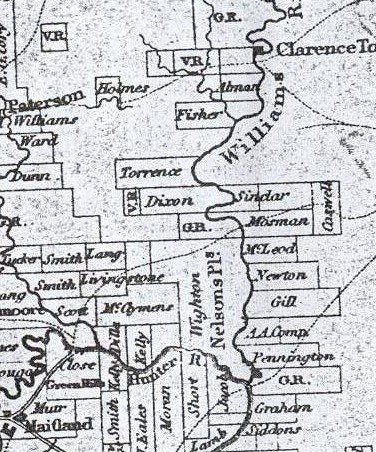Jacob Newton - Settler
Map 10
Jacob Newton was born in Edinburgh.He arrived in the colony on the Andromeda in 1823 . The Andromeda called at Hobart before proceeding to Sydney. Those passengers travelling on to Sydney included James McClymont and his wife Nancy, Beresford Hudson, David Ralston, Joseph Thew, John Morrison and wife, Michael McDonald, John McCormack and Rev. John D. Lang.
In 1823 Jacob Newton applied for a land grant and received the following reply from the Colonial Secretary's Office:
6th November 1823
Sir,
In reply to your letter of the 4th instant, I am directed by the Governor to acquaint you that he will make you a grant of 1200 acres of land in any part of the colony already surveyed and will order four convict servants to be assigned to you, who with yourself will be victualled for six months from the date of your taking possession of your said land. I am sir, F. Goulburn.

Three years later in 1826, his parents, sister and brother arrived on the Greenock, under Commander John Miller......father Andrew age 56, mother Jane age 50, brother William age 28 and sister Catherine age 8. Andrew Newton and his family also settled in the Williams River district. Others arriving in Sydney on the Greenock included Gavin Ralston, Rev. McGarvie as well as several other gentlemen.
A notice placed in the Australian by Jacob Newton in June 1827 reveals some of the difficulties for farmers in the district......
Whereas in driving cattle between Parramatta and Hunter's River a young bull not branded about 18 months old joined the flock and may be had at the farm of the undersigned upon paying the necessary expenses: Also in driving said cattle, either from the evil intentions of the men in charge, or some other reason a number were left behind. Whoever will bring the same to the farm shall receive a reward of four dollars per head for each beast so found....The Australian 13 June 1827.
By 1833 Jacob Newton was offering 1000 acres of his farm to let for the term of three or four years.. There were about 25 acres cleared of which 15 were in cultivation. There was an abundant supply of water in the driest seasons and an extensive run at the back. The soil was alluvial. Possession was offered immediately and the growing crop either paid for on a valuation or cropped when ripe by the present tenant.
Cattle rustling had become a problem in the district in the 1830's and a Society for the Protection of Stock was formed with John Wighton as Director. Jacob Newton had a number of stray cattle running between the Williams River on the west and the coast on the east and the scrubby and swampy nature of the country had prevented him making a complete muster in former years, and a number of them were without brands. In 1835 he had mustered them and disposed of all of them to the Australian Agricultural Company. [1]
He probably suffered financial hardship in the depression of the early 1840's and in 1843, the year his father Andrew died, he took out a loan of £200 from Edmond Healy of Sydney. He remained on his estate at the Williams River and in 1844 he and George Mossman were both fined for non-attendance as a jurors.
By 1845 the widow of his creditor was calling in the loan - Mary Ann Healy widow and executrix of Edmond Healy gave notice that the 460 acres used to secure the loan of £200 in 1843 was required to be repaid with interest within one month of the notice.
In August 1847 an occupation license for 1150 acres at Genena Hill occupied by Jacob Newton was about to expire and was to be re-auctioned in September of that year. Genena Hill was an early name for that area north of the Myall Lakes that later became known as Violet Hill.
In Greville's 1872 directory Jacob Newton is listed as a grazier. He died at Boolambayte Creek, Myall Lakes, in 1881.
References
[1] Sydney Gazette 5 December 1835↑
